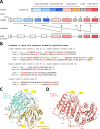Caspase Domain Duplication During the Evolution of Caspase-16
- PMID: 40392285
- PMCID: PMC12198278
- DOI: 10.1007/s00239-025-10252-w
Caspase Domain Duplication During the Evolution of Caspase-16
Abstract
Caspases are cysteine-dependent aspartate-directed proteases which have critical functions in programmed cell death and inflammation. Their catalytic activity depends on a catalytic dyad of cysteine and histidine within a characteristic protein fold, the so-called caspase domain. Here, we investigated the evolution of caspase-16 (CASP16), an enigmatic member of the caspase family, for which only a partial human gene had been reported previously. The presence of CASP16 orthologs in placental mammals, marsupials and monotremes suggests that caspase-16 originated prior to the divergence of the main phylogenetic clades of mammals. Caspase-16 proteins of various species contain a carboxy-terminal caspase domain and an amino-terminal prodomain predicted to fold into a caspase domain-like structure, which is a unique feature among caspases known so far. Comparative sequence analysis indicates that the prodomain of caspase-16 has evolved by the duplication of exons encoding the caspase domain, whereby the catalytic site was lost in the amino-terminal domain and conserved in the carboxy-terminal domain of caspase-16. The murine and human orthologs of CASP16 contain frameshift mutations and therefore represent pseudogenes (CASP16P). CASP16 of the chimpanzee displays more than 98% nucleotide sequence identity with the human CASP16P gene but, like CASP16 genes of other primates, has an intact protein coding sequence. We conclude that caspase-16 structurally differs from other mammalian caspases, and the pseudogenization of CASP16 distinguishes humans from their phylogenetically closest relatives.
Keywords: Caspase; Evolution; Protein domain; Pseudogenization; Pyroptosis.
© 2025. The Author(s).
Conflict of interest statement
Declarations. Conflict of interest: The authors declare that they have no conflict of interest. Ethical Approval: Not applicable. No procedures requiring ethics approval were performed in this study. Consent to Participate: Not applicable. Consent to Publish: Not applicable.
Figures




Similar articles
-
Caspase-14-like Proteases: An Epidermal Caspase and Its Evolutionarily Ancient Relatives.Biomolecules. 2025 Jun 22;15(7):913. doi: 10.3390/biom15070913. Biomolecules. 2025. PMID: 40723785 Free PMC article. Review.
-
The 2 Sigma Genus Concept in mammalogy: Lessons from Lasiurus.PLoS One. 2025 Jun 25;20(6):e0325554. doi: 10.1371/journal.pone.0325554. eCollection 2025. PLoS One. 2025. PMID: 40560834 Free PMC article.
-
A rapid and systematic review of the clinical effectiveness and cost-effectiveness of paclitaxel, docetaxel, gemcitabine and vinorelbine in non-small-cell lung cancer.Health Technol Assess. 2001;5(32):1-195. doi: 10.3310/hta5320. Health Technol Assess. 2001. PMID: 12065068
-
Signs and symptoms to determine if a patient presenting in primary care or hospital outpatient settings has COVID-19.Cochrane Database Syst Rev. 2022 May 20;5(5):CD013665. doi: 10.1002/14651858.CD013665.pub3. Cochrane Database Syst Rev. 2022. PMID: 35593186 Free PMC article.
-
Risk of thromboembolism in patients with COVID-19 who are using hormonal contraception.Cochrane Database Syst Rev. 2023 Jan 9;1(1):CD014908. doi: 10.1002/14651858.CD014908.pub2. Cochrane Database Syst Rev. 2023. Update in: Cochrane Database Syst Rev. 2023 May 15;5:CD014908. doi: 10.1002/14651858.CD014908.pub3. PMID: 36622724 Free PMC article. Updated.
Cited by
-
Caspase-14-like Proteases: An Epidermal Caspase and Its Evolutionarily Ancient Relatives.Biomolecules. 2025 Jun 22;15(7):913. doi: 10.3390/biom15070913. Biomolecules. 2025. PMID: 40723785 Free PMC article. Review.
References
-
- Abascal F, Zardoya R, Posada D (2005) ProtTest: selection of best-fit models of protein evolution. Bioinformatics 21:2104–2105. 10.1093/bioinformatics/bti263 - PubMed
-
- Akaike H (1998) Information theory and an extension of the maximum likelihood principle. In: Parzen E et al (eds) Selected Papers of Hirotugu Akaike. Springer, New York, pp 199–213
MeSH terms
Substances
Grants and funding
LinkOut - more resources
Full Text Sources

